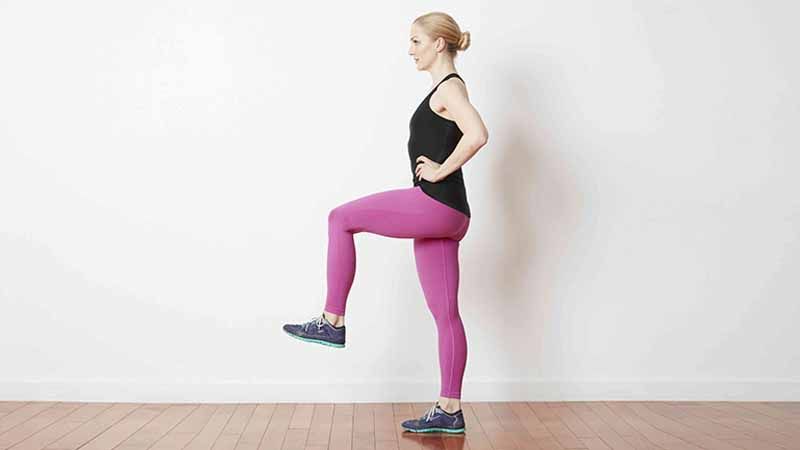How Good is Your Balancing Power? Take This 30-Second Test to Find Out
- 33 months ago
Want to flex your balancing power in front of your friends? Well, try the 30-second balance test in this blog to find out how good you are at balancing.
And if you aren't that good, we've also listed some easy-to-master steps that you can follow to improve stability and thus improve balance. So, read along.
What's the Importance of Checking Balance or Taking a Balance Test?
Balancing power is simply your body's ability to walk, cycle or jog straight without wobbling or falling.
Let's suppose you tripped over something while walking. Now, if you have good balancing power, you may catch your body midway and stand straight back. However, if you have poor balancing power, you'll most certainly fall, leading to a broken bone or any other serious injury.

Testing or checking your balancing power will help you determine how good you're at it. If you are good, it's fine. However, if you aren't, that means you need to work on your balancing power.
Enough of the information; let's check your balance with the 30-second balance test.
Take This 30-Second One-Legged Balancing Test
During this test, your eyes will be closed. So, you'll need someone to prevent you from falling and hurting yourself.
- Stand on the hardwood floor (barefoot).
- Close your eyes (not while reading the instructions!).
- Now, bend your knee and lift the other foot. If you're left-handed, bend your left knee and lift your right leg about 6 inches from the floor. And if you're right-handed, do the opposite.
- Try to stay in that position for as long as you can.
- Ask your friend/partner to note the time and how long you can stand without opening your eyes or wobbling.
- Repeat the aforementioned steps up to 3 times and then calculate your average time.
Let's say you stood for 2 seconds in the first attempt, 5 in the next, and 8 in the last attempt. Adding them together, you'll get 15 seconds in total. Now, divide 15 by 3 and you’ll get 5 seconds.
So, is 5 seconds good? Well, you can find it by comparing your time with the actual duration you're supposed to stand for below.
What Is Your Actual Balance As Per Your Age?
|
AGE |
IDEAL BALANCE AS PER AGE |
|
25-30 Years |
28 Seconds |
|
30-35 Years |
22 Seconds |
|
40 Years |
16 Seconds |
|
45 Years |
12 Seconds |
|
50 Years |
9 Seconds |
|
55 Years |
8 Seconds |
|
60 Years |
7 Seconds |
|
65 Years |
5 Seconds |
|
70 Years |
4 Seconds |
How did you do in your balancing test? Were you able to match the level of your age group? If you were, that's great, and if you weren't, that's not bad either. It's because we're going to help you improve balance or stability. But before that, let's learn why a balanced posture is required.
Why Do You Need A Balanced Posture?
A Balanced/Correct Posture:
- Reduces back pain
- Reduces the likelihood of your fall
- Improves blood flow normally across your body
- Supports your ligaments, tendons, and muscles
- Improves mobility as you age
- Reduces headache
- Improves centration

How Can You Improve Stability Or Balance?
You might have noticed (by reading the above table) that the power of balancing or the ideal balancing time reduces as we age. Well, that's how it is. But the good thing is that regardless of your age, you can improve stability. Let's learn how.
1. Tai-Chi
Tai-Chi can really help you improve balance and reduce falls if you're old and are suffering from balance issues. Also known as meditation in motion, tai-chi is easy to perform and involves small convenient movements. Here's a video you can watch to practice tai-chi.
2. One-Legged Stand With Support
Stand straight with the back of a sturdy chair facing towards you. Now, hold the chair's back for support with both your hands. Lift one of your legs up and try to remain in that position for around 10 seconds. Repeat this exercise 10-15 times while switching the legs. Do this each day, and you won't need the support of a chair.
3. Yoga And Pilates
To be able to balance your body, you need strong muscles that can bear the weight. These muscles are known as your core muscles. And to strengthen these muscles, you can perform yoga & Pilates. Both yoga (certain poses) and Pilates can help you stretch and strengthen your muscles over time.
4. Weight Shifts
Stand with your legs apart at a wide hip distance. Now, lean towards the left and put the pressure on your left leg while slightly lifting your right leg. Stay in this pose for a few seconds, then shift your weight towards the other leg. Practice this a few times a day to improve balance.
Wrapping Up
Most people don't really care about their balancing power or stability until they reach their forties and start experiencing problems. However, there's nothing to worry about, as with the aforementioned methods, you can easily improve balance and thus achieve the correct and balanced posture.
So, regardless of your age, take the 30-second balancing test and start working towards balance or posture improvement.








